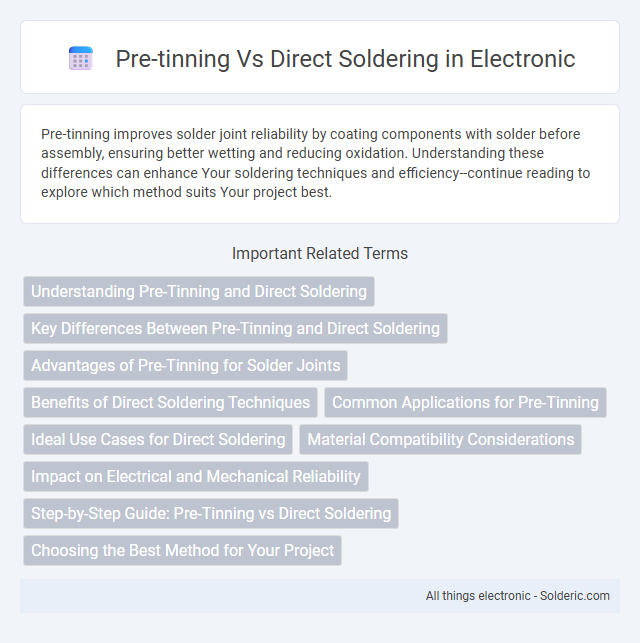Pre-tinning improves solder joint reliability by coating components with solder before assembly, ensuring better wetting and reducing oxidation. Understanding these differences can enhance Your soldering techniques and efficiency--continue reading to explore which method suits Your project best.
Comparison Table
| Aspect | Pre-tinning | Direct Soldering |
|---|---|---|
| Definition | Applying a thin layer of solder on components or wires before final soldering. | Applying solder directly to components or joints during assembly without pre-coating. |
| Process Complexity | Two-step process: pre-tinning followed by soldering. | Single-step soldering process. |
| Time Efficiency | Longer due to an additional pre-tinning step. | Faster as it eliminates pre-coating. |
| Joint Quality | Higher quality with improved solder wetting and better mechanical strength. | Good quality but sometimes less uniform wetting. |
| Oxidation Protection | Reduces oxidation risk by coating surfaces before final soldering. | Higher oxidation risk during soldering without protective layer. |
| Common Applications | Used in wire harnesses, stranded wires, and delicate components. | Standard PCB assembly and quick repairs. |
| Cost Implication | Potentially higher due to extra materials and labor. | Lower overall cost due to simpler process. |
Understanding Pre-Tinning and Direct Soldering
Pre-tinning involves coating a metal surface with a thin layer of solder before joining, which enhances solderability and prevents oxidation. Direct soldering skips this preliminary step, applying solder directly to the clean metal surface, requiring precise temperature control for a strong bond. Understanding these methods helps you choose the best technique for reliable, high-quality solder joints in electronic assembly or repair.
Key Differences Between Pre-Tinning and Direct Soldering
Pre-tinning involves applying a thin layer of solder to a component or wire before the final soldering process, enhancing electrical conductivity and preventing oxidation during assembly. Direct soldering skips this preliminary step, joining components by heating the joint and applying solder simultaneously, which can save time but may result in weaker bonds in certain applications. The choice between pre-tinning and direct soldering depends on factors such as assembly speed, joint durability, and component sensitivity to heat.
Advantages of Pre-Tinning for Solder Joints
Pre-tinning provides a uniform layer of solder on components, ensuring consistent heat distribution and improved wetting during the final soldering process. This technique enhances solder joint reliability by reducing oxidation and minimizing the risk of cold joints or voids. Your solder connections become stronger and more durable, leading to better electrical conductivity and long-term performance.
Benefits of Direct Soldering Techniques
Direct soldering techniques enhance manufacturing efficiency by eliminating the extra step of pre-tinning, reducing production time and costs. This method improves solder joint reliability through better wetting and stronger metallurgical bonds, minimizing defects such as voids or cold joints. Furthermore, direct soldering decreases the risk of oxidation and contamination, ensuring higher-quality electrical connections in electronic assemblies.
Common Applications for Pre-Tinning
Pre-tinning is widely used in electronics manufacturing, especially for preparing components and wires for assembly by coating them with a thin layer of solder to enhance solderability and reduce oxidation. It is common in cable harness production, PCB component leads, and surface-mount device terminals to ensure reliable joints during reflow soldering. Pre-tinning improves solder joint quality and consistency in applications requiring precise, controlled solder application before final assembly.
Ideal Use Cases for Direct Soldering
Direct soldering is ideal for applications requiring strong mechanical bonds and high electrical conductivity, such as in PCB assembly, automotive wiring, and aerospace electronics. It excels in environments where oxidation prevention and long-term reliability are critical, minimizing the risk of joint failure under thermal stress. This method supports complex configurations, allowing precise component placement without the extra step of pre-tinning wires or terminals.
Material Compatibility Considerations
Pre-tinning provides a protective layer that improves solderability and reduces oxidation, making it ideal for metals like copper and brass, which can be sensitive to direct soldering. Direct soldering requires precise temperature control to avoid damaging heat-sensitive materials such as aluminum or certain coated metals, which may not bond well without pre-tinning. Your choice between pre-tinning and direct soldering should consider the base metal's composition and surface condition to ensure optimal joint strength and longevity.
Impact on Electrical and Mechanical Reliability
Pre-tinning improves electrical and mechanical reliability by creating a uniform solder coating that enhances wetting and reduces oxidation, resulting in stronger, more consistent joints. Direct soldering can save time but risks insufficient solder adhesion and increased defects due to surface contaminants or uneven heat distribution. Your choice between pre-tinning and direct soldering impacts the durability and conductivity of connections, with pre-tinning offering better long-term performance in critical applications.
Step-by-Step Guide: Pre-Tinning vs Direct Soldering
Pre-tinning involves coating the component lead or pad with a thin layer of solder before the final soldering, enhancing heat transfer and ensuring a reliable bond. Direct soldering skips the pre-tinning step, applying molten solder directly onto the joint, which demands precise temperature control and faster work to avoid cold joints or damage. Choosing between these methods depends on the application's complexity, component sensitivity, and desired solder joint quality.
Choosing the Best Method for Your Project
Pre-tinning offers enhanced solder joint reliability by applying a protective layer of solder to components or wires before assembly, reducing oxidation and improving heat transfer. Direct soldering, on the other hand, streamlines the process by soldering components directly, which can save time and materials but may risk weaker joints if not done carefully. Evaluating factors like component sensitivity, project complexity, and desired durability helps you choose the best method to ensure optimal solder integrity for your project.
Pre-tinning vs direct soldering Infographic

 solderic.com
solderic.com